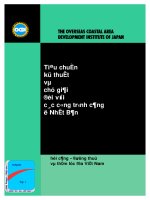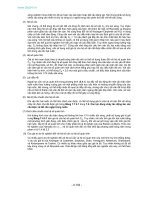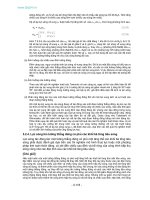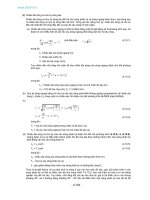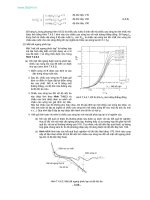Các chuẩn kỹ sư CNTT Nhật Bản - Chuan CNTT Nhat Ban itcbok
Bạn đang xem bản rút gọn của tài liệu. Xem và tải ngay bản đầy đủ của tài liệu tại đây (189.92 KB, 19 trang )
Information Technology Engineers Skill Standards
IT Common Body of Knowledge
Contents
1.
Overview ................................................................................................................................1
2.
IT Common Body of Knowledge...........................................................................................4
Translated this Skill Standard Updated version on December 11,2000
Updated version on March 19,2001
from Japanese into English on November 17,2000
Japan Information Processing Development Corporation
Central Academy of Information Technology
Information Technology Engineers Skill Standards (Overview)
1.
1.1
While these guidelines need to define the level of knowledge, skills and
capability to be equipped with by IT personnel (engineers) who do the actual
jobs in the industrial world, they need to define the models of IT engineers
who can be accepted internationally, and the ways how schools and other
educational institutions should conduct education training on the basis of
these models.
Overview
Background of developing the “Information Technology
Engineers Skill Standards”
At present, great hopes are placed on information technology as the sources of
industry regeneration and new economic growth. This is because the roles of
IT have been expanded from the tools for manufacturing cost reduction and
service speedup to those for effective collaboration among enterprises and the
creation of new industries. From now on, the rise or fall of an enterprise will
be determined by quality of computerization investment. It is therefore an
urgent matter to bring up engineers who construct advanced information
systems and those who utilize them.
One example of the guidelines is the “Skill Standard for IT Engineers”
developed by the Northwest Center for Emerging Technologies (NWCET)
as part of the establishment of “Skill Standards” by the US Department of
Labor.
The “Information Technology Engineers Skill Standards” have been developed
as a tool that solves the issue mentioned above, and apply to all the sections of
the information technology engineers examinations as criteria to evaluate the
skills of engineers who have been brought up. The application of this skill
standard will be significant for the industrial world in “recruiting human
resources with the guaranteed ability to do actual jobs.” For educational
institutions such as schools, this will be significant for “understanding and
confirming the knowledge, ability, and the achievement levels of the engineers
required by enterprises.” For government agencies, this will be significant for
“grasping the technical level of the entire industrial world.”
In view of this, the Central Academy of Information Technology has repeated a
study on how to bring up, evaluate, and select good engineers who can show
their practical ability on actual jobs. As a conclusion, the academy decided to
establish the “information technology engineers skill standards” centering on the
criteria to determine whether the required jobs can be performed adequately or
not.
1.2
Significance and objective of developing the “Information
Technology Engineers Skill Standards”
The results of surveys that the Central Academy of Information Technology
has conducted on information processing engineers have suggested an
important issue to be solved in the industrial world and by educational
institutions such as schools. The issue is the establishment of the
guidelines that clearly define the level of knowledge, skills and capability
that the industrial and educational worlds are expecting IT personnel
(engineers) to be equipped with or acquire.
-1-
Information Technology Engineers Skill Standards (Overview)
1.3
1)
What is the IT common body of knowledge?
The “IT common body of knowledge (CBOK)” shows structurally the
knowledge which is commonly evaluated in all categories (applicable persons)
in information technology engineers examinations. Reflecting the knowledge
shown in the “Information Technology Engineers Examinations: Scope of
Examinations”, this CBOK has been produced by extracting and arranging these
elements which are often made use of on the actual jobs in the development of
information systems, and which are effective to be taken up as study items in
information processing education and training.
2)
3)
The “knowledge field” basically corresponds to “Test in the morning:
Field.” However, the “security and standardization” in the examination
is divided into “security” and “standardization,” and so there are eight
knowledge fields in total.
“Major classifications” and “intermediate classifications” are sorted and
arranged in such a way as to conform to the classification shown in
“information technology engineers examinations – scope of
examination.”
“Major technical items” are technical items extracted as typically taken
up in the intermediate classifications.
(2) Technical level
(1) Structure
The examination in the morning gives questions on knowledge at the
technical level shown in the “table of questions classified by examination
categories”. In the CBOK each knowledge field includes technical items up
to level II except that Knowledge field, “I. Computer science
fundamentals” contain Level III technical items. For items of technical
level III in knowledge fields not described above, refer to the “practical
body of knowledge and core body of knowledge” in the examination
categories.
The IT common body of knowledge has the structure shown below:
Knowledge
Major classification
Intermediate classification
Major technical item
field
Knowledge field No. and name
Major classification No. and name
Intermediate classification No. and name
Items 1, 2 and 3
Items 4, 5 and 6
Items 7 and 8
Major classification No. and name
Intermediate classification No. and name
Items 1, 2 and 3
Items 4, 5
Major classification No. and name
Intermediate classification No. and name
Items 1, 2 and 3
Item 4
Intermediate classification No. and name
Items 1, 2 and 3
Items 4, 5 and 6
Note:
Knowledge field:
(3) Changes in the system and technical levels
The rapidness of information technology innovation affect intermediate
classifications in mid-term, and technical items in short term in their
themes and their priorities. This will cause changes to the contents of the
ITBOK depending on the trend of computing technologies, network
technologies, database technologies, object-oriented technologies, and so
on.
(4) Applicants in each examination category will be given questions on the
knowledge fields marked in its category column and at the technical level
indicated with the marks.
I to VIII
Major classification:
A serial No. starting with 1 in each knowledge field
Intermediate classification:
A relative No. starting with 1 appended to the major classification
No.
-2-
Information Technology Engineers Skill Standards (Overview)
Table 1: “Examination in the morning: Table of questions classified by examination categories”
Examination category
Field
Software
Application systems design
engineer
Project manager
developSystems analyst
ment
engineer
Technical engineer
Network
Database
Information
Fundamental
Senior
Systems
systems
systems
Systems information
administsecurity
Systems
auditor
technology
Embedded administ-rat administrator
manage-m
engineer
rator
systems
or
ent
Computer science
fundamentals
Computer system
System development and
operation
Network technology
Database technology
Security and standardization
Computerization and
management
Audit
Notes:
• A field marked with a circle “ ” is included in the scope of the examination in the particular category, and a field marked with a double circle “
the scope of the examination.
• Technical levels are marked with I, II and III.
Level III is the most advanced and covers level II and I, and level II covers level I.
-3-
” is an important field in
Information Technology Engineers Skill Standards (IT Common Body of Knowledge)
2.
IT Common Body of Knowledge
(MVS, UNIX, LINUX, Windows, MacOS, and Java are the trademarks of their manufacturers, vendors or organizations.)
Knowledge
field
Major
classification
Intermediate classification
Major technical item
I. Computer science
fundamentals
1.
Basic theories of information
1.1
Numeric conversion
and data representation
Radix conversion,
numeric representation (including complement representation and fractional number representation),
non-numeric value representation (character representation, voice representation, and image representation),
operation and precision (single precision, double precision, fixed point precision, floating point precision, shift operation,
overflow and underflow)
1.2
Information and logic
Logical operation (true, false, logical product, logical sum, negation, exclusive OR, negative AND, and De Morgan theorem),
proposition logic, logic function,
information logic and coding theory (channel coding, source coding, encryption, decoding, Humming code, Huffman code,
CRC, parity check),
predicate logic (deduction and induction, inference),
automaton (finite automaton, Turing machine, state transition),
formal language (definition, operation, type and grammar, Chomsky’s production rule, BNF, Polish notation, regular
expression, syntax-directed transfer method,
attribute context-free grammar, context-free language),
graph theory (directed/non-directed graph, Eulerian graph), computational complexity (large O notation), information content
(entropy),
correctness theory (partial correctness, termination, full correctness)
1.3
2.
Mathematical
applications
Numeric calculation (matrix and determinant, approximate solution, and interpolation),
probability and statistics (permutation, combination, probability, addition and multiplication theorem,
probability distribution, expectation, Markov process, estimation, testing, regression analysis),
optimization problem (linear programming method, PERT, shortest path problem, and queuing theory)
Data structures and algorithms
2.1
Data structures
Arrays (dimension, static arrays and dynamic arrays),
lists (linear list, uni-directional list, bi-directional list, ring list, linked list),
stacks (LIFO, push and pop), queue (FIFO, enqueue and dequeue),
trees (binary tree, balanced tree, ordered tree, multiway tree, search tree, heap),
hash (calculation of storage location, and collision handling)
2.2
Algorithms
Various algorithms (searching, sorting, recursive algorithm, genetic algorithm, approximate algorithm, probability algorithm,
natural language processing algorithm, language processor, linkage editor, memory management,
data compression algorithm,
collation, file processing, character string processing, graph, numeric calculation, and algorithms related to diagrams),
relationships between algorithm and data structure, algorithm efficiency,
algorithm design method, flowchart, and decision table
-4-
Information Technology Engineers Skill Standards (IT Common Body of Knowledge)
Knowledge
field
Major
classification
Intermediate classification
Major technical item
II. Computer system
1.
Hardware
1.1
Information element
Semiconductor (CMOS, bipolar, SRAM, DRAM, SDRAM, and flash memory), integrated circuit
1.2
Processor architecture
Processor structure and operation principle (register, address assignment mode, instruction set,
instruction execution control, interruption control, microprogramming control, CISC/RISC),
high-speed system (pipeline and parallel system),
operation mechanism (logical circuit, adder, and sequence circuit),
multiprocessor (tight coupling, array, tandem, loose coupling, synchronization, VLIW, super scalar),
processor performance (MIPS, clock, and CPI)
1.3
Memory architecture
Memory cache, memory capacity and performance, types of memory,
memory configuration (interleave, memory parity, ECC, layers of memory, memory protection system, and high-speed access
to main memory)
1.4
Auxiliary memory
Storage media (semiconductor, magnetic disk, magnetic tape, magneto-optical disc, and optical disk),
types and characteristics of auxiliary storage devices (HD, MO, CD, DVD, MT, etc., and access speed, volatility,
types and characteristics of RAID (RAID0, RAID1, RAID2, RAID3, RAID4, and RAID5)),
performance and capacity calculation of auxiliary storage devices (capacity, access time, blocking factor, and
defragmentation)
1.5
Input/output
architecture and
equipment
Input/output interface (bus, DMA, channel, SCSI, Centronics, GPIB, RS-232C, USB, IEEE1394, Ir-DATA, input/output
control system, and channel control system),
1.6
Types of computers,
and characteristics of
architecture
1.7
Embedded systems
types and characteristics of input/output devices (keyboard, pointing device, display, printer, various types of auxiliary
storage devices, etc.),
types and characteristics of communication control devices (modem, DCE, TA, DSU, CCU, FDM, TDM, repeater, router,
bridge, gateway, hub, and cable),
connection methods and connection media of input/output devices and communication equipment (serial connection, parallel
connection, types and characteristics of connection cable, and communication media)
Personal computer, workstation, general-purpose computer, supercomputer,
control computer, and microcomputer
Component parts and construction (processor, DSP, sensor, memory, ASIC, PWM, D/A, A/D),
logical design (processor, bus, circuit design, and timing design), and
control theory (feedback and open loop), EMI, and Co-Design
-5-
Information Technology Engineers Skill Standards (IT Common Body of Knowledge)
Knowledge
field
Major
classification
2.
Intermediate classification
Major technical item
Basic software
2.1
Operating System
OS configuration and functions,
process management (exclusive control, semaphore, state transition, preemption, round robin, execution control, deadlock),
kernel and interruption control,
main memory control (memory protection, dynamic link allocation, fragmentation, memory leak),
virtual storage (paging algorithm, slashing, and DAT),
input/output control, spooling function,
file management function (exclusive control, recovery processing, directory, file organization (sequential organization,
partitioned organization, indexed sequential organization, random organization),
access methods (BSAM, ISAM, VSAM),
program control and system call,
job management (job scheduling, JCL), real-time processing, TSS,
security control, fault management,
data management (access authorization),
multiple programming (execution order, simple execution time),
Japanese language processing, multimedia processing, human interface,
types of OS (MVS, UNIX, Linux, Windows, MacOS, free software OS)
3.
2.2
Network OS
Functions and features of network OS, network management (SNMP),
network control (types and features of protocol)
2.3
Embedded OS
Real-time OS, device driver, theory and algorithm of parallel and distributed calculation (Petri-net)
2.4
Middleware
DBMS, communication management system (including LAN control), software development support tool (including CASE
tools), operation management tool, TP monitor, ORB
System configuration and method
3.1
System configuration
technology
Client/server system (2-layer, 3-layer, multi-layer, RPC, and stored procedure),
DB/DC system, distributed DB system,
system configuration method (dual, duplex, hot standby, fault tolerant, hot site, cold site, cluster, TCMP/LCMP),
processing modes (centralized and distributed, batch, real-time system, Web type computing, use of portable computer),
transaction management (simultaneous execution control, exclusive control, failure recovery, rollback, and roll forward)
3.2
System performance
Application of queuing theory, performance calculation (response time, throughput, TAT),
performance design (system tuning, Amdahl solution, and response characteristics),
performance index (SPEC-Int, SPEC-Fp, TPC, Gibson mix, response time), performance evaluation (benchmark, and system
monitor)
-6-
Information Technology Engineers Skill Standards (IT Common Body of Knowledge)
Knowledge
field
Major
classification
Intermediate classification
3.3
4.
Major technical item
System reliability and
economical efficiency
Reliability calculation (calculation of operation rate, MTBF, MTTR, availability, failure rate, and FIT),
reliability design (fail safe, fail soft , and fool-proof),
reliability indicator and reliability evaluation (RAS, RASIS, bus tub curve, non-stop), economical efficiency (system
profitability, and operation rate)
4.1
Network application
Web, Internet, intranet, extranet, mobile communication, satellite communication, CATV,
communication services (ISDN, packet switching, frame relay, ATM, leased lines, circuit switching),
application system (Internet shopping, groupware, and debit card)
4.2
Database applications
Data warehouse (OLAP), data mart, OLTP, data mining,
application system (accounting system, inventory management system, document management system and sales support
system)
4.3
Data resource
management
4.4
Multimedia system
System application
IRDS (information resource dictionary system), meta data, and repository
AI, pattern recognition, AR/VR/CG, agent,
media application (pattern recognition and synthesis of multimedia (sound, image and video),
application system (Internet broadcast, nonlinear image edit system, video on-demand, and TV game)
-7-
Information Technology Engineers Skill Standards (IT Common Body of Knowledge)
Knowledge
field
Major
classification
Intermediate classification
Major technical item
III. System Development and Operation
1.
System Development
1.1
Language
Program structure (re-entrant, reusable, overlay, and recursion),
data type (integer type, real type, logical type, character type, abstract data type, and structure type),
control structure (branch, selection, repetition, procedure, and function),
language processors (compiler, linkage editor, loader, interpreter, assembler, cross compiler, DLL, and parallel processing),
syntactic analysis (morphogical analysis, syntax-directed transfer method, attribute context-free grammar, and context-free
language),
types and features of languages (FORTRAN, COBOL, PL/I, C, Pascal, C++, Lisp, Visual Basic, XML, SGML, PostScript,
Java, Perl),
types of languages (procedural, functional, logic and object-oriented)
1.2
Software package
Development tools, operation management tool,
business processing tools (finance and accounting, personnel affairs, management planning, sales management, inventory
control, and business application classified by industry),
ERP, CRM, SFA, SCM, CTI,
Groupware (communication, data sharing, schedule management), PDM, CAD/CAM/CEA, OA tools, (word processing
software, spread sheet, presentation software),
Others (utility, multimedia, and entry in Japanese)
1.3
Development
environment
Development tools (design tool, programming tool, test support tool, CASE tool),
EUC, EUD (use of spread sheet software, DB normalization, data manipulation and use of SQL)
1.4
Development method
Software development model (waterfall, spiral, prototype),
cost model,
process maturity levels (CMM, SPICE, SPA),
software life cycle,
software reuse (reverse engineering, componentware)
1.5
Requirements analysis
and design method
DFD, ERD, UML,
analysis/design diagramming (flowchart, NS chart, PAD),
object-oriented design (inheritance, generalization, delegation, encapsulation, polymorphism ),
process-centered design, data-centered design, structured analysis and design,
module design (module cohesion, and module coupling),
input/output design (report design, screen design, item-code design),
human interface design
1.6
Programming method
Programming method (procedural programming, logic programming, functional programming, object-oriented programming)
1.7
Test review method
Test method (white box test, black box test),
review method (inspection, walkthrough, deign review),
test design and management method (bug curve, error removal, coverage, test design, fault injection, system test and bug
management diagram )
-8-
Information Technology Engineers Skill Standards (IT Common Body of Knowledge)
Knowledge
field
Major
classification
2.
Intermediate classification
Major technical item
1.8
Development
management
Project planning (initiation of project plan, profitability),
quality plan, management and evaluation (QFD, software quality, and quality characteristics),
process management (PERT diagram, Gantt chart, WBS, progress control and critical path),
configuration management (specification management, and change control),
estimation method (function point method, COCOMO, workload estimation, and cost estimation), personnel planning and
management,
document management (document protocol, and change procedures), productivity (size and workload),
development organization and roles (development team staffing, and project manager),
cost management and risk management
1.9
Application system
construction
Design and development of application systems (use of analysis and design methods, external design, internal design,
programming, and test),
use of software packages
database design and operation (normalization, SQL, and use of network), and implementation of network
1.10 System auditability
Audit method, audit trail, significance of system audit, and incorporation into system
1.11 Use of external
resources
Outsourcing, system integration, and co-sourcing
System operation and maintenance
2.1
System operation
System operation management (computer system, database, network),
system cost management (charges to users, TCO),
system operation (job scheduling, data input/output management, and operation manuals),
user management (ID issuance and management),
distributed system management,
hardware resource management,
software resource management (library management, and version control),
data resource management,
network resource management,
equipment and facility management (power supply, air conditioning equipment, equipment management, and facility
management),
system failure management (handling procedures, monitoring, recovery process, and preventive measures),
security management,
performance management,
system operation tool (automatic operation tool, monitoring tool, and diagnostic tool),
system transition (transition to operation phase, operation test, and version control),
system operation service criteria
2.2
System maintenance
Types of maintenance (daily inspection, periodical maintenance, preventive maintenance, post maintenance, and remote
maintenance),
software maintenance, hardware maintenance, and maintenance contract
-9-
Information Technology Engineers Skill Standards (IT Common Body of Knowledge)
Knowledge
field
Major
classification
Intermediate classification
Major technical item
IV. Network technology
1.
2.
3.
Protocol and transmission control
1.1
Network architecture
Network topology,
standardization of communication protocol (OSI layer, X, V, I, and HDLC),
application layer protocol (FTP, TELNET, SNMP, DHCP, POP, and SMTP),
transport layer protocol (TCP, and UDP),
network layer protocol: IP (IP address (subnet address, subnet mask),
physical address (uni-cast, broadcast, and multi-cast)),
data link layer protocol (ARP and PPP)
1.2
Transmission control
Connectionless system, contention system, polling/selecting system, basic procedure, multi-link procedure,
transmission control character, line control, and HDLC
Encoding and transmission
2.1
Modulation and
encoding
AM, FM, PM, PCM, and sampling,
analog transmission, digital transmission, coding, and compression
2.2
Transmission
technology
Error control (CRC, Humming code, parity check, bit error ratio),
synchronous control (start-stop synchronization, SYN synchronization, flag synchronization, and frame synchronization),
multiplexing methods (FDM, TDM),
compression and decompression methods (JPEG, MPEG, MH, MR, MMR, run-length)
2.3
Transmission and
methods circuits
Communication methods (unidirectional/half duplex/full duplex, series/parallel, 2-wire/4-wire), WDM,
switching system (circuit switching, store and forward, packet switching, ATM switching, frame relay, and cell relay),
public network, and leased line
Network (LAN and WAN)
3.1
LAN and WAN
Transmission media (types and features of cables),
LAN topology (bus type, star type, and ring type),
Access control system (CSMA/CD, token ring),
inter-LAN connection, LAN-WAN connection,
peer-to-peer, point-to-point,
high speed technology of LAN (FDDI, gigabit ether),
wireless LAN
3.2
Internet
Internet technology (inter-network connection equipment, TCP/IP, IP routing, DNS, PROXY server),
e-mail (protocol, mailing list), Web (HTTP, browser, URL, HTML, and XML),
file transfer (FTP), search engine (full text search type, directory type, robot type), QoS, CGI, and VOIP
3.3
Network performance
Calculation related to line, transmission speed, line utilization rate, line capacity, traffic intensity, traffic design and
performance evaluation,
application of queuing theory
3.4
Laws related to
network
The followings are Japan-localized national or domestic laws: Telecommunications carrier regulations and laws, Wire
Telecommunications Law, Broadcast Law, Radio Law, Cable Television Broadcast Law, technical standards
- 10 -
Information Technology Engineers Skill Standards (IT Common Body of Knowledge)
Knowledge
field
Major
classification
4.
5.
Intermediate classification
Major technical item
3.5
Network security
Encription, authentication, firewall, and security protocol
3.6
Telecommunications
services
Leased line service, line switching service, packet switching service, ISDN, VPN,
frame relay, cell relay, ATM, IP connection service, satellite communication service,
mobile communications service, international communication service, VAN (value added communication network),
QoS, DSL, best effort/guaranteed service
Communications equipment
4.1
Transmission media
and communication
cable
Wire, wireless, radio wave, light, infrared rays, local line, toll line,
pair cable, coaxial cable, optical fiber cable, IDF, and MDF
4.2
Various types of
communications
equipment
Line terminal devices, multiplexing equipment, switching equipment, branch equipment,
inter-network connection equipment (gateway, bridge, spanning tree, router, repeater, hub, and switch),
line connection equipment (modem, DSU, NCU, TA, CCU, and PBX)
5.1
Network management
Network management items (network operation management, configuration management, failure management, performance
management, and accounting management),
network management system, and network management tool (SNMP)
5.2
Network OS
Network driver, and functions of network OS
Network software
- 11 -
Information Technology Engineers Skill Standards (IT Common Body of Knowledge)
Knowledge
field
Major
classification
Intermediate classification
Major technical item
V. Database technology
1.
2.
3.
Models of database
1.1
Database model
3-layer schema (conceptual schema, external schema, and internal schema), conceptual data model,
logical data model (relation model, hierarchical model, and network model)
1.2
Data analysis
Data modeling,
ERD (entity, attribute, relationship),
Normalization (1st normal form, 2nd normal form, and 3rd normal form)
1.3
Data manipulation
Relational algebra (set operation (sum, difference, product, direct product), relational operation (selection, projection,
combination, quotient))
2.1
Database language
Data definition language, data manipulation language, and end user language
2.2
SQL
Data manipulation by SQL (table definition, data retrieval, data addition/deletion/update)
2.3
API
Creation of program using embedded type SQL
Creation of program using module language
3.1
Functions and features
of DBMS
Major functions (database definition function, database manipulation function, database control function, transaction
management, and user view function),
features (assurance of data independence, database access, simultaneous execution process, exclusive control, failure
recovery, and security),
RDB, OODB, ORDB, and NDB
3.2
Control function of DB
Exclusive control of DB,
DB recovery (rollback, roll forward),
DB transaction management function (ACID attribute)
3.3
Distribution database
Configuration of distributed database,
client cache,
2-phase commit, 3-phase commit, and
replication
Database language
Database control
- 12 -
Information Technology Engineers Skill Standards (IT Common Body of Knowledge)
Knowledge
field
Major
classification
Intermediate classification
Major technical item
VI. Security
1.
2.
Approaches to secure computing
1.1 Confidentiality and
tempering prevention
measure
1.2
Protection against
illegal intrusion and
computer viruses
1.3
Integrity
1.4
Availability
1.5
1.6
Risk management
2.1
Risk analysis
2.2
Types of risks
2.3
Countermeasures
against risks
Internal control
2.4
3.
Privacy protection
Safety
Guidelines and related laws and regulations
3.1 Guideline for security
3.2
Guideline for privacy
protection
Cryptograph (public keys, private keys, DES, RSA, cryptograph algorithms),
authentication (digital signature, message authentication, callback, user confirmation),
access control (access right, password), digital watermarking,
security management (entry and exit control, leakage prevention)
Firewall,
security protocol (SSL, PGP),
hardware security,
computer viruses, and computer vaccine
Data entry integrity,
database integrity,
software integrity, and
log and audit trail management
File backup,
recovery, alternate or spare communication lines and communication control equipment, and
reliability theory
Individual’s information control, anonymity, pen names, and non-traceability
Countermeasures against natural calamity (earthquake-proof), housing security, and UPS
Risk identification, risk control, risk evaluation,
risk analysis methods (quantitative risk analysis, qualitative risk analysis, and JRAM)
Classification by peril concepts (fire, natural disaster, crime, illegal access, failures, etc.),
classification by hazard concepts (physical hazard, moral hazard, etc.)
Risk hedge (risk transfer, risk finance, computerization insurance), and
contingency plan (classification of contingency, action plan against contingency, backup measure, and recovery plan)
Security regulation,
security policy, and
organization for security
Standards for information system safety measures,
software management guideline,
standard for preventing computer viruses, and
standard for preventing illegal access to computers
OECD guideline,
guideline for individual’s information protection, and
individual’s information protection registration mark system
- 13 -
Information Technology Engineers Skill Standards (IT Common Body of Knowledge)
Knowledge
field
Major
classification
Intermediate classification
Major technical item
VII. Standardization
1.
Standardization for development and acquisition
1.1
1.2
2.
3.
4.
Standardization for
development and
acquisition processes
ISO9000, ISO/IEC 12207 (SLCP-ICF98), ISO10006
Standardization for
evaluation of
environment and
security
ISO14000, ISO15408
Standardization for information system
infrastructure
2.1
Standards
International standards (ISO, IEC), Japanese standard (JIS), American standards (ANSI), industrial standard (EIAJ-EDI
standard, CI-NET, distribution EDI standard), and enterprise standards
2.2
Open systems
X/Open, OSF, POSIX, COSE
2.3
Standardization for data
exchange
EDIFACT, STEP, Zen-gin (all Japan banking) procedures, CII, XML
2.4
Component-based
software
standardization
CORBA, EJB
Standardization of data
3.1
Standardization of
codes
Character codes (ASCII, ISCII, EBCDIC, JIS, shift-JIS, Unicode),
bar codes (JAN code, ITF code, and ISBN code)
3.2
Standardization of file
formats
JPEG, GIF, BMP, TIFF, MPEG,
SGML, XML, HTML, TEX, data formats (CSV format, SYLK format), PDF
3.3
International System of
Unit (SI)
Basic measurement units (meter, gram/kilogram/ton, second/minute/hour, ampere,
kelvin, degree of Celsius, mole, candela),
new SI measurement units (newton, pascal, joule, watt)
Standardization organizations
4.1
Standardization
organizations
International organizations (ISO, IEC, IETF, IEEE, ITU), US public organizations (ANSI, FCC, NIST, MIL, and DOD),
European public and industrial organizations (BSI, CENELEC, ECMA), Japanese public organization (JISC, JSA),
industrial bodies (PCMCIA, ECMS, EIA, JEDEC, The Open Group), and Japanese industrial organizations (JEITA (Japan
Electronics and Information Technology Industries Association))
- 14 -
Information Technology Engineers Skill Standards (IT Common Body of Knowledge)
Knowledge
field
Major
classification
Intermediate classification
Major technical item
VIII. Computerization and management
1.
2.
3.
4.
Information strategy
1.1
Business management
Business strategy (portfolio, CSF, competitive analysis),
organizations (CEO, CIO, CFO, COO, matrix organization, operating division organization, project team organization),
marketing (marketing mix, price strategy, marketing research),
behavioral science (motivation, group dynamics, leadership, KJ method, brain storming),
system theories (general system theories, social systems)
1.2
Computerization
strategy
Information system (DSS, SIS, system evaluation, ERP, SCM, CRM, SFA, KMS, ASP, EAI),
computerization conception (overall plan, medium- and long-term plan), systematization plan,
business improvement, analysis, design (BPR, operation model, and business model),
Businesses using internet (E-business/dot com business, virtual companies, and SOHO)
2.1
Financial accounting
Accounting standard, financial statements (balance sheet, income statement),
consolidated accounting (consolidated balance sheet, consolidated income statement, and consolidated cash flow account
statement), and depreciation
2.2
Management
accounting
Break-even point, financial index (financial analysis, financial ratio analysis), cost (cost calculation, cost accounting system,
cost analysis, and construction of cost),
lease and rental,
fund plan, fund management (statement of cash receipts and disbursement, statement of source and application of funds),
asset management (inventory control, valuation, and portfolio),
tax accounting (corporate income tax, consumption tax, fixed assets tax), and economic efficiency calculation (DCF, IRR,
remunerative comparison)
Accounting
Management engineering
3.1
IE
IE analysis method (working hour analysis, work sampling, ABC analysis), OC curve, control charts (7 QC tools, Pareto’s
chart, and distribution chart)
3.2
OR
Optimization problem (linear programming, inventory control),
decision-making theory, game theory,
probability and statistics, distribution function,
Markov process, and simulation
Use of information system
4.1
Engineering system
field
Production control system, production plan (productivity index), process plan and management (JIT, production line
organization), MRP, CAD/CAM/CAE, FA, CIM, PDM
4.2
Business system field
Accounting, finance and personnel affairs systems, sales support system, OA system, POS, distribution system, financial
system, inter-enterprise system(VAN, EDI, CALS, EC), groupware, and work flow control tool
- 15 -
Information Technology Engineers Skill Standards (IT Common Body of Knowledge)
Knowledge
field
Major
classification
5.
Intermediate classification
Major technical item
Related laws and regulations
5.1
Laws and regulations
concerning information
communication
The followings are Japan-localized national or domestic laws: Telecommunications Industry Law, Wire Telecommunications
Law, Broadcast Law, Radio Law, Cable Television Broadcast Law
5.2
Laws and regulations
concerning intellectual
property right
Copyright Law, Patent Law, industrial property right laws (Utility Mode Act, Designs Act, and Trademark Law)
5.3
Laws and regulations
concerning labor
Laborer Dispatch Law, Labor Standard Law (3-6 agreement, night and holiday work), Law concerning the Promotion of
Equal Opportunity and Treatment between Men and Women, Child Care Leave Law, Employment Security Law, Industrial
Safety and Health Law, Employment Insurance Law, and Workmen’s Accident Compensation Insurance Law
5.4
Laws and regulations
concerning transactions
Unfair Competition Prevention Law, Regulations Concerning Outsourcing (contract, contract for dispatch, consignment,
commission, international transactions),
Regulations concerning software sales (maintenance responsibility, license contract, shareware), securities and exchange
Law, Civil Law, Visiting Sales Laws
5.5
Law and regulations
concerning safety
5.6
Other related laws and
regulations
The Product Liability Law, Illegal Access Prevention Law, CE Marking, and Communication Interception Law
Criminal laws (crime as false electromagnetic record or sharing of original copy, crime as illegal creation or sharing of
electromagnetic record, crime as obstruction of business by breaking computers, etc. crime as fraud using computer, and
crime as destruction of electromagnetic record),
Commercial Laws (commercial transaction, stocks, directors, auditors, affiliate companies, and bills),
Electronic Register Retention Law, Open Information Law (The Act for Protection of individual’s information)
Certification system (system integrator certification, SO certification, information processing engineer certification), and New
Business Creation Promotion Law
- 16 -
Information Technology Engineers Skill Standards
Publisher
IT Common Body of Knowledge
Japan Information Processing Development Corporation
Central Academy of Information Technology
19th Floor, Time 24 Building, 2-45 Aomi, Koto-ku, Tokyo 135-8073
Tel
+81 3 5531 0171 (key number)
Fax
+81 3 5531 0170
URL
July 31, 2000
Japan Information Processing Development Corporation
Published on July 31, 2000

